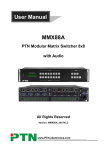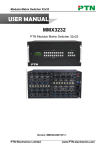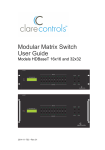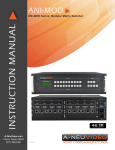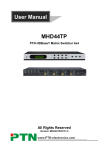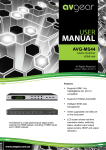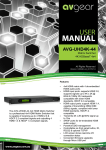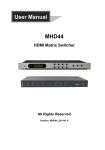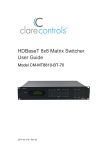Download AVG-DMM1616 User Manual
Transcript
AVG-DMM1616 Features The AVG-DMM1616 is a high-performance video and audio modular matrix switcher supporting a maximum of 16 input signal sources and 16 output displays synchronously. Modular chassis with configurable I/O slots, ranging from 4x4 to 16x16. Various I/O cards, includes HDMI, HDBaseT, SD/HD/3G-SDI, DVI and VGA cards (Compatible with YUV, YC & CVBS.) to configure any matrix. True cross-point switching, any input to any output, regardless of signal format. Supports HDMI1.4a, supports 3D. Supports 4K. Integrated HDBaseT technology. Controllable via button, RS232 & optional TCP/IP, also compatible with 3rd party control systems. HDCP compliant. LCD display. AVG-DMM1616 PLEASE READ THIS PRODUCT MANUAL CAREFULLY BEFORE USING THIS PRODUCT. This manual is only for operation instruction only, and is not to be used in a maintenance capacity. The functions described in this version are current as at March 2015. Any changes of functions and operational parameters will be updated in future manual versions. Please refer to your dealer for the latest product details. Version 1.0 1/3/15 AVG-DMM1616 SAFETY OPERATION GUIDE In order to guarantee the reliable operation of the equipment and safety of the user, please abide by the following procedures in installation, use and maintenance: 1. The system must be earthed properly. Please do not use two blade plugs and ensure the AC power supply ranges from 100v to 240v and from 50Hz to 60Hz. 2. Do not install the switcher in an environment where it will be exposed to extreme hot or cold temperatures. 3. This unit will generate heat during operation, please ensure that you allow adequate ventilation to ensure reliable operation. 4. Please disconnect the unit from mains power if it will be left unused for a long time. 5. Please DO NOT try to open the casing of the equipment, DO NOT attempt to repair the unit. Opening the unit will void the warranty. There are high voltage components in the unit and attempting to repair the unit could result in serious injury. 6. Do not allow the unit to come into contact with any liquid as that could result in personal injury and product failure. AVG-DMM1616 TABLE OF CONTENTS Introduction .............................................................................................................. 1 Introduction to the AVG-DMM1616............................................................... 1.1 Features ....................................................................................................... 1.2 MMX signal card (changeable cards) ................................................ 1.2.1 What’s in the Box ........ ……………………………………………………………………2 Product Appearance of the AVG-DMM1616 ........................................................... 3 Front Panel ................................................................................................... 3.1 Rear Panel.................................................................................................... 3.2 Changeable Cards........................................................................................ 3.3 4I-DV & 4O-DV ................................................................................ 3.3.1 4I-DS& 4O-DS ................................................................................. 3.3.2 4I-HD & 4O-HD ................................................................................ 3.3.3 4I-VG & 4O-VG ................................................................................ 3.3.4 4I-VA ............................................................................................... 3.3.5 4I-SD & 4O-SD ................................................................................ 3.3.6 4I-TP & 4O-TP ................................................................................. 3.3.7 4I-UH & 4O-UH ................................................................................ 3.3.8 4I-UF & 4O-UF ................................................................................. 3.3.9 4I-BT & 4O-BT ............................................................................... 3.3.10 System Connection .................................................................................................. 4 System Applications ..................................................................................... 4.1 Usage Precautions ....................................................................................... 4.2 Connection Diagram ..................................................................................... 4.3 System Operations................................................................................................... 5 Front Panel Button Control ........................................................................... 5.1 IR Control ..................................................................................................... 5.2 RS232 Control .............................................................................................. 5.3 Connection with the RS232 Communication Port ........................... 5.3.1 RS232 Communication Commands ................................................ 5.3.2 TCP/IP Control ............................................................................................. 5.4 Control Modes ................................................................................ 5.4.1 TCP/IP Settings .............................................................................. 5.4.2 Specifications ........................................................................................................... 6 Main Unit ...................................................................................................... 6.1 Changeable Cards........................................................................................ 6.2 4I-DV & 4O-DV ................................................................................ 6.2.1 4I-DS& 4O-DS ................................................................................. 6.2.2 4I-HD & 4O-HD ................................................................................ 6.2.3 4I-VG & 4O-VG ................................................................................ 6.2.4 AVG-DMM1616 4I-VA ............................................................................................... 6.2.5 4I-SD & 4O-SD ................................................................................ 6.2.6 4I-TP & 4O-TP ................................................................................. 6.2.7 4I-UH & 4O-UH ................................................................................ 6.2.8 4I-UF & 4O-UF ................................................................................. 6.2.9 4I-BT & 4O-BT ............................................................................... 6.2.10 Troubleshooting & Maintenance ............................................................................. 7 AVG-DMM1616 1. Introduction 1.1. Introduction to the AVG-DMM1616 The AVG-DMM1616 is a high-performance video and audio modular matrix switcher from our Digital Media Matrix range. It supports a maximum of 16 input signal sources and 16 output displays synchronously. It supports different video signals with true cross-point switching. Every video and audio signal is transmitted and switched independently to decrease signal attenuation. The AVG-DMM1616 supports various interchangeable cards including HDMI, 4K, DVI, VGA, SDI, Fiber Optic and HDBaseT etc, and all the cards support hot plug & play. Users can choose to insert different signal cards for different applications. The AVG-DMM1616 has a power fail memory function and audio can break away from or follow the video switched. It has an RS232 port for serial control and an optional IP port for TCP/IP control, it can also be easily controlled by third-party devices. With its flexible design, the AVG-DMM1616 can be used for a range of projects and is capable of being an ‘all-in-one solution’. It is the perfect solution for multimedia conference rooms, control rooms, broadcasting rooms, shopping centers etc. It is comfortable handling all the audiovisual management, including the switching, driving, scaling etc. 1.2. Features Modular chassis with configurable I/O slots, ranging from 4x4 to 16x16. Various I/O cards, includes HDMI, HDBaseT, SD/HD/3G-SDI, DVI and VGA cards (Compatible with YUV, YC & CVBS.) to configure any matrix. True cross-point switching, any input to any output, regardless of signal format. Supports HDMI1.4a, supports 3D, 4K cards available. Integrated HDBaseT technology. Controllable via button, RS232 & optional TCP/IP, also compatible with 3rd party controllers. HDCP compliant. LCD display. AVG-DMM1616 1.2.1. MMX signal card (changeable cards) To suit different applications and users, the AVG-DMM1616 cards are classified into the following models: Spec Inputs Signal Format 4I-HD 4I-DV 4I-DS 4 4 4 4I-VG 4I-VA 4 4 HDMI DVI DVI, HDMI, VGA, AV, YPbPr VGA VGA& PCM audio Inputs Signal Format 4 inputs & 4 LOOP outputs for each channel) 4 4 4 4 SDI Models Spec Models 4I-SD 4I-TP 4I-UH 4I-UF 4I-BT HDMI TP, IR, RS232 HDMI& PCM Audio Optical Fiber HDBT, RS232, Audio Input Cards Spec Outputs Signal Format 4O-HD 4O-DV 4O-DS 4 4 4 4O-VG 4O-SD 4 VGA, 4 Stereo audio 4 outputs & 4 LOOP outputs for each channel) 4 4 4 4 HDMI DVI DVI, HDMI, VGA, AV, YPbPr VGA, analog audio SDI Models 4O-TP 4O-UH 4O-UF 4O-BT HDMI TP, IR, RS232 HDMI& PCM Audio Optical Fiber HDBT, RS232, Audio AVG-DMM1616 2. Package List 1 x AVG-DMM1616 1 x RS232 cable 4 x Plastic cushions 1 x IR remote (The cell battery is not included) 1 x Power Cord 1 x User manual Note: Please confirm if the product and the accessories are all included, if not, please contact your dealer. AVG-DMM1616 3. Product Appearance of the AVG-DMM1616 3.1. Front Panel No. ① ② Name ③ ④ IR Power indicator LCD screen INPUTS ⑤ OUTPUTS ⑥ MENU Description IR sensor, receives IR signal sent from IR remote Illuminates red once powered on Displays real-time operation status Buttons for input channels with green back-light indication, ranges from 0~ 9, 16 selectable channels in total. Buttons for output channels with green back-light indication, ranges from 0 ~ 9, 16 selectable channels in total. AV: transfer video and audio signal synchronously ,: division button, to divide the output channels when switching to more than one channel. UNDO: Undo button, to resume to the status before the command just performed. ENTER: confirm switching operation. Operation will not be executed by the matrix without confirmation. ALL: select all input/output channel THROUGH: To transfer the signals directly to the corresponding output channels. : Backspace button, to backspace the latest input button. Note: Pictures shown in this manual are for reference only. AVG-DMM1616 3.2. Rear Panel No. Name ① ② ③ INPUTS OUTPUTS Power switch TCP/IP RS232 Power ports ④ ⑤ ⑥ Description Input signal card slots, 4 in total Output signal card slots, 4 in total Switch between AC110V and AC230V to access different power (Optional) Used for TCP/IP control port Serial control port, connect with RS232 port of control device. Connect with household alternating current power, including one redundant power. Note: There are only 4 input and 4 output slots for AVG-DMM1616, which enables only 4 input cards and 4 output cards to be installed on AVG-DMM1616. The input/output cards can be changed based on your requests and supports hot plug and play. Pictures shown in this manual are for reference only. 3.3. Changeable Cards AVG-DMM1616 support expansion through various changeable input/ output cards of different signals including DVI, HDMI, VGA, twisted pair, SDI etc. Here is a brief introduction to the changeable cards. AVG-DMM1616 3.3.1. 4I-DV & 4O-DV DVI signal card. (Please check the specification from 5.2.1) It is fully compatible with HDMI1.3 and HDCP, but not supporting analog signals. It uses embedded EDID management technology, supporting DDC. 4I-DV: input card, maximum four input signals. Input signals can pass to an output device through 4O-DV, or pass through other series output cards. 4O-DV: output card, maximum four output signals, output signals from 4I-DV, or other series of input cards. Pin Layout of the DVI-I connector (Dual-Link). (Female) PIN 1 2 3 Function T.M.D.S.Data2T.M.D.S.Data2+ T.M.D.S. Data 2/4 Shield PIN 13 14 15 4 5 6 7 T.M.D.S. Data 4T.M.D.S. Data 4+ DDC Clock DDC Data 16 17 18 19 8 9 10 Analog Vertical Sync T.M.D.S.Data1T.M.D.S.Data1+ 20 21 22 11 12 T.M.D.S.Data1/3 Shield T.M.D.S.Data3- 23 24 Function T.M.D.S.Data3+ +5V Power Ground (return for +5V, Hsync and Vsync) Hot Plug Detect T.M.D.S. Data 0T.M.D.S. Data 0+ T.M.D.S. Data 0/5 Shield T.M.D.S.Data5T.M.D.S.Data5+ T.M.D.S. Clock Shield T.M.D. S. Clock + T.M.D.S .Clock- AVG-DMM1616 3.3.2. 4I-DS& 4O-DS Seamless DVI signal card. (Please check the specification from 5.2.2) It is fully compatible with HDMI1.3 and HDCP 1.2, and supports seamless transmission for high-definition DVI, HDMI, VGA, AV, YPbPr signals. It can automatically identify the format of the input signal, and the output resolution can be adjusted. It uses embedded the EDID management technology, supporting DDC. 4I-DS: seamless input card, maximum four input signals. Input signals can pass to output devices through 4O-DS, or pass through the other series of output cards. 4O-DS: seamless output card, maximum four output signals. Output signals can come from 4I-DS, or from the other series input cards. It supports memory off function for resolution, signal format and HDCP compliance status. Note: When 4O-DS works with input cards except 4I-DS, adjust the 4 input signals to any one of the following 5 resolutions to enable seamless output: 1024x768, 1280x720, 1600x1200, 1920x1080, 1920x1200. DVI interfaces on the signal card are the same as the interfaces on 4I-DV& 4O-DV. 3.3.3. 4I-HD & 4O-HD HDMI signal card. (Please check the specification from 5.2.3) It uses embedded EDID management technology, supporting DDC. It is also compatible with DVI signal (HDCP required). 4I-HD: input card, maximum four input signals. Input signals can pass to an output device through 4O-HD, or pass through other series output cards. AVG-DMM1616 4O-HD: output card, maximum four output signals, output signals from 4I-HD, or other series input cards. Pin layout of the HDMI connectors (female). No. 1 2 3 4 5 6 7 8 9 10 Signal Name TMDS Data 2+ TMDS Data 2 Shield TMDS Data 2TMDS Data 1+ TMDS Data 1 Shield TMDS Data 1TMDS Data 0+ TMDS Data 0 Shield TMDS Data 0TMDS Clock+ No. 20 19 18 17 16 15 14 13 12 11 Signal Name SHELL Hot Plug Detect +5V Power Ground DDC Data DDC Clock No Connect CEC TMDS ClockTMDS Clock Shield 3.3.4. 4I-VG & 4O-VG VGA signal card. (Please check the specification from 5.2.4) Scale all inputs to 1080p. Compatible with C-Video, YUV, YC (Factory preset function). The bandwidth is up to 350MHz (-3dB); Supporting RGBHV, RGsB, RGBS, RsGsBs, YUV, YC and Composite video. 4I-VG: input card, maximum four input signals. Input signals can pass to output devices through any series output cards. 4O-VG: output card, maximum four VGA output signals and 4 stereo audio outputs, output video signal from 4I-VG, or other series input cards, outputs audio signal from the audio of the input signal. AVG-DMM1616 Pin layout of the VGA connectors (female): Pin Number Pin 1 Pin 2 Pin 3 Pin 4 Pin 5 Pin 6 Pin 7 Pin 8 Signal Name RED GREEN BLUE ID2/RES GND RED_RTN GREEN_RTN BLUE_RTN Pin Number Pin 9 Pin 10 Pin 11 Pin 12 Pin 13 Pin 14 Pin 15 Connect the devices via VGA converting cable as shown below: Connect with Component Video (YPbPr) Source Connect with Composite Video (C-VIDEO) Source Signal Name KEY/PWR GND ID0/RES ID1/SDA HSync VSync ID3/SCL AVG-DMM1616 3.3.5. 4I-VA VGA signal card. (Please check the specification from 5.2.5) Scale all inputs to 1080p. Compatible with C-Video, YUV, YC (Factory preset function). Supporting RGBHV, RGsB, RGBS, RsGsBs, YUV, YC and Composite video. 4I-VA: input card, maximum four VGA inputs and four stereo audio inputs. Input signal can pass to output devices through any series of output cards. The VGA connector and source connection is same with the 4I-VG. 3.3.6. 4I-SD & 4O-SD SDI signal card. (Please check the specification from 5.2.6) It is compatible with different SDI signal formats, including SD/HD/3G-SDI (adaptive) Every port has a loop output for local monitoring. 4I-SD: input card, maximum four input signals. Input signals can pass to output devices through 4O-SD, or pass through other series output cards. 4O-SD: output card, maximum four output signals, output signals from 4I-SD, or other series input cards. The BNC connector is shown as the figure below. AVG-DMM1616 3.3.7. 4I-TP & 4O-TP Twisted pair card (HDMI/DVI extender). (Please check the specification from 5.2.7) Supports HDTV, compatible with HDMI1.3 and HDCP 4I-TP: input card, maximum input four HDMI TP signals. Input signals can pass to output devices through 4O-TP, or pass through other series output cards, designed to work with the AVGTPHD402T. 4O-TP: output card, maximum output four HDMI TP signal, output signals from 4ITP, or other kinds of input cards, designed to work with the AVG-TPHD402R. Pin layout of the RJ45 connectors: Two different connection standards can be chosen; the connectors of the same cable should use the same standard at each end. TIA/EIA T568A TIA/EIA T568B Cable color Cable color 1 green white 1 orange white 2 green 2 orange 3 orange white 3 green white 4 blue 4 blue 5 blue white 5 blue white 6 orange 6 green 7 brown white 7 brown white 8 brown 8 brown AVG-DMM1616 Note: Cable connectors MUST be metal, and the shielded layer of the cable MUST be connected to the connector’s metal shell, to ensure reliable grounding. 3.3.8. 4I-UH & 4O-UH 4K HDMI signal card. (Please check the specification from 5.2.8) Supports hotplugging, HDMI 1.4& HDCP 1.4 compliant; Compatible with DVI signal; Supports high-definition HDMI sources up to 4kx2k, 1080p 3D compliant; Provides auxiliary audio port to output the HDMI embedded audio. It uses embedded EDID management technology. 4I-UH: input card, maximum four input signals. Input signals can pass to output devices through 4O-UH, or pass through other series output cards. 4O-UH: output card, maximum four output signals, output signals from 4I-UH, or other series input cards, HDCP compliant status set via RS232 command. 3.3.9. 4I-UF & 4O-UF 4K optical signal card. (Please check the specification from 5.2.9) Supports hotplugging; High bandwidth: 10.2Gbps; Compliant with HDMI 1.4, able to transmit 4K×2K& 1080P 3D (max) signals; Supports multi-mode transmission up to 300m and single mode transmission up to 1km. 4I-UF: input card with indicators, maximum four input signals, corresponding indicator illuminates green when there is an input signal. Input signals can pass to output devices through 4O-UF, or pass through other series output cards. AVG-DMM1616 4O-UF: output card with indicators, maximum four output signals, output signals from 4I-UF, or other series input cards; corresponding indicator illuminates green when there is an output signal. Note: Use the 4I-UF/ 4O-UF with optical fiber transmitter/ receiver. 3.3.10. 4I-BT & 4O-BT Twisted pair card (HDMI/DVI extender). (Please check the specification from 5.2.10) Supports hot-plug, supports HDTV, compatible with HDBT 1.0, HDMI1.4a& HDCP1.4; Wide resolution range from 480p to 4kx2k, 1080p 3D compliant; Extends HDBT signals up to 70m at 1080p or 40m at 4k; Bi-directional RS232 transmission on a single cable; Auxiliary audio ports support a stereo signal. It uses embedded EDID management technology. 4I-BT: input card, maximum input four HDMI TP signals. Input signals can pass to output devices through 4O-BT, or pass through other series output cards, designed to work with the HDBT transmitter AVG-TPHD402T. 4O-BT: output card, maximum output four HDBT signal, output signals from 4I-BT, or other series input cards, designed to work with the HDBT receiver AVG-TPHD402R. AVG-DMM1616 4. System Connection 4.1. System Applications Reliable performance for control and transmission makes the AVG-DMM1616 ideal in the IT computer space, signal monitoring, big screen displays, conference systems, television broadcast, education, banking and security institutions etc. 4.2. Usage Precautions 1. System should be installed in a clean environment with temperature and humidity maintained to within equipment specification. 2. All of the power switches, plugs, sockets and power cords should be insulated and safe. 3. All devices should be connected before power is turned on. 4.3. Connection Diagram AVG-DMM1616 5. System Operations 5.1. Front Panel Button Control Users can control the AVG-DMM1616 simply and directly with its front panel buttons. To switch AV/ and A/ V signal, please operate the buttons using the following format: Format: “Input Channel” + “AV” +“Output Channel “+“Enter” Note: 1) “Switch Mode”: Audio & Video synchronous (AV) or break away switching mode (Audio/ Video) 2) “Input Channel”: Push the number of the input channel to be controlled, 3) “Output Channel”: Push the number of the output channels to be controlled. Press “All” to select all the outputs. 4) Use “,” button to separate multiple I/O channels, and press the “ENTER” button to confirm the operation. 5) The input/output channels on the rear panel are slotted from left to right, top to bottom. 6) The input delay time between two numbers of every input & output channel must be less than 5 seconds; otherwise the operation will be cancelled. Example: 1. To transfer input 1 to output 11, press input “1”, output “0” “1” and “Enter”. 2. To transfer signals from input 1 to all output channels, press buttons in this order: “1”, “All”. Other Functional Buttons: Buttons UNDO Description Returns to the previous status Backspace the last operation THROUGH Get one to one I/O connection, e.g. input 1-> output 1, input 2-> output 2. Operation State 1: Input 6 -> output 6 Press input “6” + “AV”+ output 4 to change the connection. Press “Undo” to return to State 1. If you press buttons “1”, “AV”, “2”, “ ” in order, then “2” will be canceled. Format: “Input Channel”+”Through” If you press buttons “ALL”, “THROUGH” in order, then the result will be like input 1 output 1, input 2 output 2, input 3 output 3 … input 16 output 16. AVG-DMM1616 5.2. IR Control With the IR remote, the AVG-DMM1616 can be controlled remotely. As the function buttons on the IR remote are the same as the ones on the front panel, the IR remote shares the same operations and commands with the control panel. Press the buttons in below format: “Input Channel” + “Switch Mode” +“Output Channel” Input channel buttons, including 1~10+ Menu buttons, including switching buttons and function buttons Output channel buttons, including 1~10+ AVG-DMM1616 5.3. RS232 Control 5.3.1. Connection of the RS232 Communication Port In addition to the front control panel and IR remote, the AVG-DMM1616 can be controlled by a far-end control system using the Ethernet port or via the RS-232 communication port. This RS-232 communication port is a female 9- D connector. The definition of its pin layout is shown in the table below. No. 1 2 3 4 5 6 7 8 9 Function N/C Unused Tx Transmit Rx Receive N/C Unused Gnd Ground N/C Unused N/C Unused N/C Unused N/C Unused AVG-DMM1616 5.3.2. RS232 Communication Commands Baud rate: 9600 Type Data bit: 8 Command /*Type; /%Lock; Stop bit: 1 Parity bit: none Recall[Y]. Clear[Y]. PWON. Description Query the models information. Lock the keyboard of the control panel on the Matrix. Unlock the keyboard of the control panel on the Matrix. Query the version of firmware Turn off the feedback command from the com port. It will only show the “switcher OK”. Turn on the feedback command from the com port. To cancel the previous operation. Switch to the “demo” mode, 1->1, 2->2, 3->3 … and so on. Transfer signals from the input channel [x] to all output channels Transfer all input signals to the corresponding output channels respectively. Switch off all the output channels. Transfer signals from the input channel [x] to the output channel [x]. Switch off the output channel [x]. Switch on all the output. Switch on output [x]. Transfer the video signals from the input channel [x1] to the output channel [x2]. Transfer the audio signals from the input channel [x1] to the output channel [x2]. Transfer signal from the input channel [x1] to the output channel [x2]. Query the input channel to the output channel [x]. Query the input channel to the output channels one by one. Save the present operation to the preset command [Y]. [Y] ranges from 0 to 9. Recall the preset command [Y]. Clear the preset command [Y]. Power ON. PWOFF. HDCPON. HDCPOFF. /V00. Enter into standby mode. Turn on the HDCP output. Turn off the HDCP output. Query the version of backboard software. /%Unlock; /^Version; /:MessageOff; /:MessageOn; Undo. Demo. [x]All. All#. Commands for Main Unit All$. [x]#. [x]$. All@. [x]@. [x1]V[x2]. [x1]A[x2]. [x1]B[x2]. Status[x]. Status. Save[Y]. AVG-DMM1616 Type Command UpgradeIntEDID[x]. EDIDUpgrade[x]. EDID/[x]/[y]. EDIDG[x]. EDIDMInit. EDIDM[X]B[Y]. USER/[Y]/[X]:*****; 0911%. USER/I/[x]:0622%; USER/I/[x]:0623%; USER/I/[x]:0624%; USER/I/[x]:0625%; USER/I/[x]:0626%; Commands for Main Unit USER/I/[x]:0627%; USER/I/[x]:0628%; USER/I/[x]:0619%; USER/I/[x]:0621%; USER/I/[x]:0629%; USER/I/[x]:0620%; USER/I/[x]:0617%; USER/I/[x]:0606%; USER/I/[x]:0698%; Description Upgrade built-in EDID data. Supports 6 types of EDID data (see Note 6). When the switcher gets the command, it will show a message to send EDID file (.bin file). Upgrade EDID data of input ports When the switcher gets the command, it will show a message to send EDID file (.bin file). Operations will be canceled after 10 seconds. Set the EDID data of input port [x] to built-in EDID data of type [y]. The value of [y] varies from 1~6. The EDID data types are same as mentioned above. Get EDID data from output channel X and display the data on serial port control software. [x] is the output port number. Recover the factory default EDID data for every input channel. Manual EDID switching. Enable input [Y] to learn the EDID data of output[X]. If there is problem learning the EDID data, it will automatically set the default EDID data for input [Y]. Custom command for signal cards, [Y]=I/O; [X]= port number; *****: User-definable command, e.g. 0623% Restore factory default. 4I-VA Set the signal of input channel [x] to VGA. Set the signal of input channel [x] to YCBCR. Set the signal of input channel [x] to SVIDEO. Set the signal of input channel [x] to CVIDEO. Set the resolution of input [x] to 1024x768@60Hz. Set the resolution of input [x] to 1280X720@60Hz. Set the resolution of input [x] to 1280X800@60Hz. Set the resolution of input [x] to 1360X768@60Hz. Set the resolution of input [x] to 1600X1200@60Hz. Set the resolution of input [x] to 1920X1080@60Hz. Set the resolution of input [x] to 1920X1200@60Hz. Restore to factory default. Auto-adjust VGA signal Update software AVG-DMM1616 Type Command USER/I/[x]:0698%; USER/I/[x]:0622%; USER/I/[x]:0623%; USER/I/[x]:0624%; USER/I/[x]:0625%; USER/I/[x]:0626%; USER/I/[x]:0627%; USER/I/[x]:0628%; USER/I/[x]:0629%; USER/I/[x]:02xx%; USER/I/[x]:03xx%; USER/I/[x]:04xx%; USER/I/[x]:05xx%; USER/I/[x]:0606%; USER/I/[x]:0607%; USER/I/[x]:0608%; USER/I/[x]:0614%; USER/I/[x]:0617%; USER/I/[x]:0619%; USER/I/[x]:0626%; USER/I/[x]:0627%; USER/I/[x]:0628%; USER/I/[x]:0629%; USER/I/[x]:0620%; USER/I/[x]:0621%; USER/I/[x]:0698%; USER/I/[x]:0686%; USER/I/[x]:0687%; USER/O/[x]:0201%; USER/O/[x]:0202%; USER/O/[x]:0203%; Description 4I-VG Update software Set the signal of input channel [x] to VGA. Set the signal of input channel [x] to YCBCR. Set the signal of input channel [x] to SVIDEO. Set the signal of input channel [x] to CVIDEO. Set the resolution of input [x] to 1024x768@60Hz. Set the resolution of input [x] to 1280X720@60Hz. Set the resolution of input [x] to 1280X800@60Hz. Set the resolution of input [x] to 1920X1080@60Hz. 4I-DS Set the brightness of input [x] to xx, xx=00~99 Set the contrast of input [x] to xx, xx=00~99 Set the saturation of input [x] to xx, xx=00~99 Set the sharpness of input [x] to xx, xx=00~99 (For 4I-DS/ VA) Auto-adjust VGA input signal Set picture’s color temperature Configure image scale Configure picture mode Restore to factory default. Set the resolution of input [x] to 1360x768, HD Set the resolution of input [x] to 1024x768, XGA Set the resolution of input [x] to 1280x720, 720P Set the resolution of input [x] to 1280x800, WXGA Set the resolution of input [x] to 1920x1080, 1080P Set the resolution of input [x] to 1920x1200, WUXGA Set the resolution of input [x] to 1600x1200, UXGA Software update Set the output signal of input [x] to HDMI Set the output signal of input [x] to DVI 4O-DS Set the input source of output [x] to YPbPr Set the input source of output [x] to VGA Set the input source of output [x] to C-VIDEO AVG-DMM1616 Type Command USER/O/[x]:0804%; USER/O/[x]:0813%; USER/O/[x]:0824%; USER/O/[x]:0826%; USER/O/[x]:0837%; USER/O/[x]:0106%; USER/O/[x]:0107%; GetResolution[x]. GetVGAPortMode[x]. AUDIO[X]I[Z]. Description Set the resolution of output [x] to 1280x720P @60Hz Set the resolution of output [x] to 1280x1080P @60Hz Set the resolution of output [x] to 1024x768 @60Hz Set the resolution of output [x] to 1280x1024 @60Hz Set the resolution of output [x] to 1920x1200 @60Hz Switch on the HDCP compliance of output [x] Switch off the HDCP compliance of output [x] Capture output resolution of output [x] Query the output status of VGA port [x] 4I-UH/BT Select audio source from audio inputs or AV signal inputs Notes: 1. Please disconnect all the twisted pairs before sending command EDIDUpgrade[X]. 2. In above commands, “[”and “]” are symbols for easy reading and do not need to be typed in actual operation. 3. Please remember to end the commands with the ending symbols “.” or “;”. 4. Type the command carefully, it is case-sensitive. 5. Commands pertaining to EDID only available for signal cards that support EDID management. 6. The switcher boasts 6 in-built EDID data memories, the chart below illustrates the detailed information: AVG-DMM1616 No. 1 2 3 4 5 6 Detailed Information 1080p 2D 5.1CH 1080p 2D 2.0CH 720p 2D 5.1CH 720p 2D 2.0CH 4kx2k 2D 5.1CH 4kx2k 2D 2.0CH Update in-built EDID data by sending command UpgradeIntEDID[x]. Examples: 1. Transfer signals from an input channel to all output channels: [x]All. Example: Send “3All.” to transfer signals from the input 3 to all output channels. 2. Transfer all input signals to corresponding output channels respectively: All#. Example: If this command is carried out, the status of matrix will be: 1->1, 2->2, 3->3, 4->4…… 8->8…. 3. Switch off all the output channels: All$. Example: After running this command, there will be no signals on all the outputs. 4. Switch off the detail feedback command from the COM port: /:MessageOff; But, it will leave the “switch OK” as the feedback, when you switch the matrix. 5. Switch on the detail feedback command from the COM port: /:MessageOn; It will show the detail switch information when it switch. Example: when switch 1->2, it will feedback “AV01 to 02”. 6. Transfer signals from an input channel to corresponding output channel: [x]#. Example: “5#.” to transfer signals from the input5 to the output5. 7. Switch off an output channel: [x]$. Example: “5$.” to switch off the output 5. AVG-DMM1616 8. Switch signal: [x1] B[x2]. Example: “12B12,13,15.” to transfer signal from input12 to output No.12,13,15. 9. Query the input channel to the output channel [x]: Status[x]. Example: Send “Status3.” to Query the input channel to the output 3. 10. Query the input channel to the output channels one by one: Status. Example: “Status.” to Query the input channel to the output channels one by one. 11. Save the present operation to the preset command [Y]: Save[Y]. Example: “Save7.” to save the present operation to the preset command No.7. 12. Recall the preset command [Y]: Recall[Y]. Example: “Recall5.” to recall the preset command No.5. 13. Clear the preset command [Y]: Clear[Y]. Example: “Clear5.” to clear the preset command No.5. 14. EDID management command:. EDIDM[X]B[Y]. Example: “EDIDM5B3.” to enable input 3 to learn the EDID data of output 5. 15. Command for signal cards: USER/[Y]/[X]*****. Example: “USER/I/7:0623%;” to set the input 7 to support YPbPr signal, the card is plugged in the second input slot of the matrix. AVG-DMM1616 5.4. TCP/IP Control 5.4.1. Control Modes TCP/IP default settings: IP is 192.168.0.178, Gateway is 192.168.0.1, and Serial Port is 4001. IP & Gateway can be changed as you need, Serial Port cannot be changed. Controlled by Single PC Connect a computer to the TP port of the AVG-DMM1616, and set its IP address and gateway to the same IP and gateway as the AVG-DMM1616’s (Default: 192.168.0.178). Same IP and gateway as the switcher AVG-DMM1616 Controlled by PC(s) in LAN Connect the AVG-DMM1616, a router and several PCs to setup a LAN (as shown in the following figure). Set the IP Subnet and gateway of the AVGDMM1616 to the same as the routers to allow PC’s system control over the LAN. Follow these steps to connect the devices: Step 1. Connect the TCP/IP port of the AVG-DMM1616 to Ethernet port of PC with twisted pair. Step 2. Set the PC’s IP address and gateway to the same as the AVGDMM1616’s. Do please remember the PC’s original IP address and gateway. Step 3. Set the AVG-DMM1616’s IP address and gateway to the same IP subnet as the router. Step 4. Set the PC’s IP address and gateway the same as the original settings. Step 5. Connect the AVG-DMM1616 and PC(s) to the router. PC(s) within the LAN are able to control the AVG-DMM1616 asynchronously. 5.4.2. TCP/IP Settings Step 1. Connect the TCP/IP port of the AVG-DMM1616 to Ethernet port of a PC with twisted pair. Step 2. Set the PC’s IP and gateway to the same IP subnet as the default IP of the AVG-DMM1616 (192.168.0.178). Step 3. Enter the http://192.168.0.178:100 into an Internet Explorer browser, you will see the LOGIN page. Step 4. Enter user name “admin” and password “admin”, then press the Enter button. (Not the Enter key on your keyboard.) Then you can enter the configuration page to configure the IP port, including the IP reset, Serial reset and password reset etc. As picture below: AVG-DMM1616 Step 5. Change IP/Serial Port Change IP a) Select the tab “system info” and then you are able to change the IP. b) Press the button Apply to save your settings. Then the PC(s) in this LAN (connected with this router) will be able to control the matrix switcher. Change Serial Port a) Select the tab “serial info”, and then you are able to change the serial port. AVG-DMM1616 b) Set the port number to 4001 (unique, other numbers are unavailable). c) Press the button Apply on present page to save your settings. Step 6. Select the tab “reset device”, then your settings will be loaded to the AVGDMM1616. AVG-DMM1616 6. Specifications 6.1. Main Unit Serial control port TCP/IP control Front Panel Power Supply Temperature Dimension W (*H*D) Control RS-232, 9- female D connector RJ45 Port Push Button control General 100VAC ~ 240VAC, 50/60Hz -10 ~ +40℃ 483 x 133x 320mm (3U high) Configurations 2 = TX, 3 = RX, 5 = GND Power Consumption Humidity Weight 84W (Max) 10% ~ 90% 3.5Kg 6.2. Changeable Cards 6.2.1. 4I-DV & 4O-DV Input Input Input Connector Input Level Input Impedance General Gain Video Signal Max Timedelay EDID and DDC HDCP 4 DVI Female DB24+5 T.M.D.S. 2.9V~3.3V 75Ω 0 dB Output Output Output Connector output Level Output Impedance 4 DVI Female DB24+5 Bandwidth 340 MHz (10.2 Gbit/s) 200ns (Max.) DVI 1.0/HDMI 1.3 full digital T.M.D.S Switching signal Speed 5nS (±1nS) Crosstalk T.M.D.S. 2.9V~3.3V 75Ω <-50dB@5MHz Supports Extended Display Identification Data (EDID) and Display Data Channel (DDC) data using DVI and HDMI standards. EDID and DDC signals are actively buffered Compliant with HDCP using DVI and HDMI 1.3 standards AVG-DMM1616 6.2.2. 4I-DS & 4O-DS Input Input Input Connector Input Level Input Impedance General Gain 4 DVI Female DB24+5 Video Signal HDCP Output Output Connector output Level Output Impedance 4 DVI Female DB24+5 0 dB Bandwidth DVI,HDMI,VGA,CVIDEO,YPbPr 5nS (±1nS) Switching Speed Crosstalk 340 MHz (10.2 Gbit/s) 200ns (Max.) T.M.D.S. 2.9V~3.3V 75Ω Max Timedelay EDID and DDC Output T.M.D.S. 2.9V~3.3V 75Ω <-50dB@5MHz Supports Extended Display Identification Data (EDID) and Display Data Channel (DDC) data using DVI and HDMI standards. EDID and DDC signals are actively buffered Compliant with HDCP using DVI and HDMI 1.3 standards 6.2.3. 4I-HD & 4O-HD Input Input Input Connector Input Level Input Impedance General Gain Video Signal Switching Speed EDID and DDC HDCP 4 HDMI Female HDMI T.M.D.S. 2.9V/3.3V Output Output Output Connector output Level 75Ω Output Impedance 0 dB DVI 1.0/HDMI 1.4a full digital T.M.D.S signal 200ns (Max.) Bandwidth Max Timedelay Crosstalk 4 HDMI Female HDMI T.M.D.S. 2.9V/3.3V 75Ω 6.75Gbit/s 5nS (±1nS) <-50dB@5MHz Supports Extended Display Identification Data (EDID) and Display Data Channel (DDC) data using DVI and HDMI standards. EDID and DDC signals are actively buffered Compliant with HDCP using DVI and HDMI 1.4a standards AVG-DMM1616 6.2.4. 4I-VG & 4O-VG Input Input Input Connector Input Level Input Impedance General Gain Video Signal Switching Speed 4 VGA Female 15 pin HD 0.5 ~ 2.0Vp-p 75Ω Output Output Output Connector 4 VGA Female 15 pin HD Output Level Output Impedance 0.5 ~ 2.0Vp-p 75Ω 0 dB Bandwidth 350MHz (-3dB), fully load VGA-UXGA, RGBHV, RGBS, RGsB, RsGsBs, component video, S-video & C-video. 200ns (Max.) Crosstalk <-50dB@5MHz 6.2.5. 4I-VA Input Video Input Input Connector Input Level Input Impedance General Gain Video Signal Switching Speed Audio 4 VGA Input Female 15 pin Input HD Connector 0.5 ~ 2.0Vp-p CMRR 75Ω Input Impedance 0 dB Bandwidth 4 Stereo Audio 3P Captive connector >90dB @20Hz ~ 20KHz >10KΩ YPbPr:170MHz; C-video:150MHz; VGA:170MHz VGA-UXGA, RGBHV, RGBS, RGsB, RsGsBs, component video, Svideo& composite video. 200ns (Max.) Crosstalk <-50dB@5MHz AVG-DMM1616 6.2.6. 4I-SD & 4O-SD Input Input Input Connector Input Level 4 SDI Female BNC Input Impedance General Gain 75Ω Output 0.8Vp-p ± 10% Unity Transmission 300M (Max.) Distance Input Return <-14 dB @ 1 MHz ~ 1.5 GHz Loss Video Standard Audio Bits per Sample SMPTE 292M, SMPTE 259M, SMPTE 424M, ITU-RBT.601, ITURBT.1120 18 bits per channel, 2 channels (L, R) Output Output Connector output Level Output Impedance 4 SDI Female BNC Maximum Data Rate Data rate Lock Input Return Loss Data Type 2.97 Gbps 0.8Vp-p ± 10% 75Ω Auto <-14 dB @ 1 MHz ~ 1.5 GHz 8bit, 10bit 6.2.7. 4I-TP & 4O-TP Video Input Input Input Connector 4 RJ45 Female RJ45 3.5mm mini jack for IR 3 poles captive screw connector for RS232 Input 75Ω Impedance Video General Gain 0dB ~ 10dB@100MHz Resolution 800x600 ~ 1920x1200 range SNR >70dB@ 100MHz100M Video Output Output Output Connector Output Impedance 4 RJ45 Female RJ45 3.5mm mini jack for IR 3 poles captive screw connector for RS232 75Ω Bandwidth Transmission Distance 6.75Gbps 70M(Max) Return Loss <-30dB@ 5KHz AVG-DMM1616 THD <0.005%@1KHz Min.~Max. Level HDMI Standard Support HDMI1.4a and HDCP Differential Phase Error <0.3V ~ 1.45Vp-p ±10° @ 135MHz_100M 6.2.8. 4I-UH & 4O-UH Input Video Input Input Input Connector 4 HDMI Female HDMI Video Output Input Input Connector Min.~Max. Level Input Impedance Output Video Output Output Output Connector T.M.D.S. 2.9V~3.3V Input Impedance 4 Analog 3.5mm pluggable terminal block 75Ω 100Ω (Differential) Frequency Response 20Hz~20K Hz 4 HDMI Female HDMI Audio Output Output Output Connector Min.~Max. Level Output Impedance General Gain Max Resolution Transmission Distance Work Temperature SNR T.M.D.S. 2.9V~3.3V Output Impedance 4 Stereo 3.5mm Stereo audio connector 75Ω 100Ω (Differential) Frequency Response 20Hz~20K Hz 0dB 4Kx2K Bandwidth Crosstalk 1080P≤70m 4Kx2K ≤ 40m -10℃~+40℃ Switching Speed 6.75Gbps <50dB@5MHz 200ns (Max.) Reference Humility 10%~90% Supported Audio Format HDMI Standard EDID& HDCP Management >70dB@ 100MHzReturn Loss <-30dB@ 100M 5KHz Embedded HDMI audio: PCM, Dobly Digital, DTS, DTS-HD Analog audio: PCM Supports HDMI1.4& DVI1.0 Compliant with HDCP 1.4; Supports manual EDID management AVG-DMM1616 6.2.9. 4I-UF & 4O-UF Input Input Input Connector Fiber Type 4 Fiber Optical SPF Fiber Optical Connector Multi-mode, Single mode Output Output Output Connector Fiber Type 4 Fiber Optical SPF Fiber Optical Connector Multi-mode, Single General Data Rate 10.2 Gbps Color Depth 8bit, 10bit, 12bit, 16bit Work Reference 0~55℃ 10%~90% Temperature Humility Optical Fiber Mode Connector LC connector Resolution Up to 4Kx2K Transmission 1km (Single mode transmission, using Single Mode Optical Distance Module and OS1 Single Mode Fiber Cable) 300m (Multi-mode transmission, using Single/ Multi mode Optical Module and OM3 Multi-Mode Fiber Cable) Data Rate 10.2Gbit/s 6.2.10. 4I-BT & 4O-BT Input Video Input Input Input Connector Min.~Max. Level Input Impedance Output Video Output Output Output Connector Audio Input 4 HDBT Input 4 Female Input RJ45 (with dualConnector color indicator) T.M.D.S Input Impedance 2.9V~ 3.3V 100Ω Frequency Response (Different ial) 4 HDBT 4 Female RJ45 (with dual-color 4 Stereo 3.5mm Stereo audio connector 75Ω 20Hz~20K Hz Audio Output Output Output Connector 4 Stereo 3.5mm Stereo audio connector AVG-DMM1616 Min.~Max. Level Output Impedance Control Part Control Signal Protocol General Gain Max Resolution Transmission Distance Work Temperature SNR Supported Audio Format HDMI Standard EDID& HDCP Management indicator) T.M.D.S 2.9V~ 3.3V 100Ω (Differential) 4 RS232 Output Impedance 75Ω Frequency Response 20Hz~20K Hz Control Connector 3-pin pluggable terminal block Bandwidth Crosstalk Switching Speed 6.75Gbps <-50dB@5MHz 200ns (Max.) Reference Humility Return Loss 10%~90% TCP/IP 0dB 4Kx2K 1080P≤70m 4Kx2K ≤ 40m -10℃~+40℃ >70dB@ <-30dB@ 5KHz 100MHz-100M Embedded HDMI audio: PCM, Dobly Digital, DTS, DTS-HD Analog audio: PCM Supports HDMI1.4 Compliant with HDCP 1.4; Supports manual EDID management AVG-DMM1616 7. Troubleshooting & Maintenance Problems Color loss or no video signal output Causes The Connection of the cabling may be incorrect or faulty Failed or loose connection No signal at the input / output end Failed or loose connection No Video output when switching Solutions Check whether the cables are connected correctly and in working condition. Make sure the connection is good Check with oscilloscope or multimeter if there is any signal at the input/ output end. Make sure the connection is good Send command Input source is with HDCP /%[Y]/[X]:1. or change while the HDCP HDCP compliance status compliance is switched off. in GUI. Switch for another input The display doesn’t source or enable the support the input display to learn the EDID resolution. data of the input. Send command /%Unlock; Cannot control the device Front panel buttons are or select unlock in GUI via front panel buttons locked. interface to unlock Flat Remote Battery Change battery. Send it to authorized Faulty Remote dealer for repairing. Beyond the effective range Adjust the distance and Cannot control the device of the IR signal or not angle and point right at the via IR remote pointing at the IR receiver IR receiver. The IR receiver connected Change for an IR receiver to IR IN/ IR ALL IN port is with carrier. without carrier Power Indicator remains Failed or loose power Check whether the cables off when powered on connection are connected correctly Change for another HDMI EDID management does Faulty HDMI Cable cable which is in good not work normally working condition. Switch again. Manage the EDID data The display does not manually to make the There is a blank screen on support the resolution of resolution of the video the display when switching the video source. source automatically compliant with the output resolution. AVG-DMM1616 Problems Causes Wrong connection Cannot control the device by control device (e.g. a PC) through RS232 port Wrong RS232 communication parameters Broken RS232 port Static becomes stronger when connecting the video Bad grounding connectors Cannot control the device The device has a previous by RS232 / IR remote / fault front panel buttons Solutions Check to ensure the connection between the control device and the unit Type in correct RS232 communication parameters: Baud rate:600; Data bit: 8; Stop bit: 1; Parity bit: none Send it to an authorized dealer for checking. Check the grounding and make sure it is connected well. Send it to an authorized dealer for repairing.









































